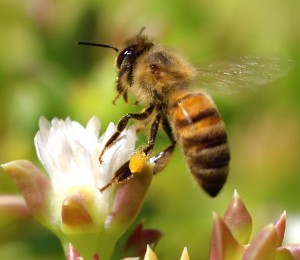23
Dec
Native Bee Populations on Decline on U.S. Farms
(Beyond Pesticides, December 23, 2015) Native bees are on the decline in some of the major agricultural regions in the United States, according to a new study. The study scientists produced the first national map of bee populations and identified numerous trouble areas. Since 2006, honey bees and other pollinators in the U.S. and throughout the world have experienced ongoing and rapid population declines. The continuation of this crisis threatens the stability of ecosystems, the economy, and food supply, as one in three bites of food are dependent on pollinator services.
 The study, titled Modeling the status, trends, and impacts of wild bee abundance in the United States and published in the journal Proceedings of the Natural Academy of Science, for the first time aims to assess the status and trends of wild bees and their potential impacts on pollination services across the U.S. and found that between 2008 and 2013 bee abundance declined across 23% of the nation’s land area. The decline is generally associated with conversion of natural habitats to row crops. The researchers also list pesticide use, climate change, and disease as other threats to wild bees. The researchers specifically cited 139 counties as especially worrisome, with wild bee numbers decreasing while farmland for crops dependent on such pollinators is increasing. The counties include agricultural regions of California such as the Central Valley, as well as the Pacific Northwest, the upper Midwest and Great Plains, west Texas and the southern Mississippi river valley.
The study, titled Modeling the status, trends, and impacts of wild bee abundance in the United States and published in the journal Proceedings of the Natural Academy of Science, for the first time aims to assess the status and trends of wild bees and their potential impacts on pollination services across the U.S. and found that between 2008 and 2013 bee abundance declined across 23% of the nation’s land area. The decline is generally associated with conversion of natural habitats to row crops. The researchers also list pesticide use, climate change, and disease as other threats to wild bees. The researchers specifically cited 139 counties as especially worrisome, with wild bee numbers decreasing while farmland for crops dependent on such pollinators is increasing. The counties include agricultural regions of California such as the Central Valley, as well as the Pacific Northwest, the upper Midwest and Great Plains, west Texas and the southern Mississippi river valley.
Earlier this year, researchers at Cornell University found that as the use of pesticides on apple orchards in New York State increased, the abundance of wild bees declined significantly. The researchers analyzed wild bee populations on 19 apples orchards across the state of New York between 2011 and 2012. Data was broken down by class of pesticide (fungicide, insecticide, herbicides), and timing of applications (before, during, and after flower bloom). Researchers also analyzed the percentage of natural areas within the surrounding landscape. Wild bee numbers declined significantly as pesticide use increased, but the overall impact of pesticides on wild bees was found to be highest in generations following pesticide exposure, indicating that pesticides affect bee reproduction or offspring. Further, researchers found that fungicides, widely regarded as having low toxicity to bees, had a measurable impact on wild bee abundance. “High and repeated exposure was the likely explanation” for this finding, according to the study. Fungicide applications prior to apple flower blooming resulted in the steepest decline in wild bee abundance and diversity. This result indicates that wild bees are visiting orchards before apple trees begin to bloom. Further, researchers found insecticide applications affected bees the mostly after bloom occurred. The authors explain that, while honey bees are placed in orchards for a short time during bloom, wild bees are more frequently exposed to chemical pesticides because they continue to forage in and around apple orchards before and after the bloom period.
In this latest study, the counties grew crops such as almonds, pumpkins, squashes, blueberries, watermelons, peaches and apples that are highly dependent on pollinators, or had large amounts of less-pollinator-dependent crops including soybeans, canola and cotton.
According to US News, Taylor Ricketts, Ph.D., director of the University of Vermont’s Gund Institute for Ecological Economics, said the 139 counties represent 39% of the pollinator-dependent crop area of the United States and most likely will face inadequate pollination in the future. “Wild bee declines may increase costs for farmers and, over time, could even destabilize crop production,” Dr. Ricketts said.
Their decline may prompt greater dependence on commercial honeybee colonies for pollinating crops, but honeybee numbers also are falling, added Gund Institute researcher Insu Koh, PhD, the lead author of the study.
“Our results highlight the need for strategies to maintain pollinator populations in farmland, and the importance of conservation programs that provide flowering habitat that can support wild bees and other pollinators,” said Michigan State University entomologist Rufus Isaacs, who heads the U.S. Department of Agriculture-funded Integrated Crop Pollination Project.
The study follows a 2014 memorandum by Barack Obama creating a task force to study pollinator losses. The task force in May called for preserving wide swathes of pollinator habitats, yet falls short of recommendations submitted by Beyond Pesticides, beekeepers, and others who stress that pollinator protection begins with strong regulatory action and suspension of bee-toxic pesticides.
The Saving America’s Pollinator’s Act of 2015 remains an avenue for Congress to address the pollinator crisis. Contact your U.S. Representative and ask them to support this important legislation today. You can also get active in your community to protect bees by advocating for policies that restrict their use. Montgomery County, Maryland recently restricted the use of a wide range of pesticides, including neonicotinoids, on public and private property. Sign here if you’d like to see your community do the same!
All unattributed positions and opinions in this piece are those of Beyond Pesticides










